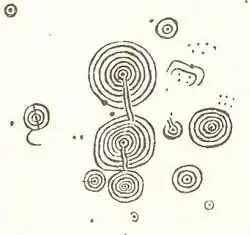Cochno Stone


The Cochno Stone is a large cup and ring marked rock at Auchnacraig, Faifley, West Dunbartonshire, Scotland,[1] next to the Cochno farm.[2] It is also known variously as "Whitehill 1"[3]: 9 and "the Druid Stone".[3]: 2
The Bronze Age rock art is found on a stone measuring 42 by 26 feet (12.8 by 7.9 metres), and was documented in 1887 by the Rev. James Harvey.[3]: 3 It features around 90 carved indentations, considered to be one of the finest sets of petroglyphs in Scotland.[4]
The stone was reburied in 1965 to protect it against vandalism. In 2015 it was partially re-exposed for investigation during a 3-day dig by a team involving archaeologists from the University of Glasgow,[5] with a more complete re-exposure following a year later.[6]
References
- ^ Historic Environment Scotland. "Whitehill (Site no. NS57SW 32)". Retrieved 20 June 2025.
- ^ "Dig to unearth prehistoric Cochno Stone". BBC News. 7 September 2016. Retrieved 1 October 2017.
- ^ a b c Brophy, Kenneth (March 2018). "'The finest set of cup and ring marks in existence': the story of the Cochno Stone, West Dunbartonshire" (PDF). Scottish Archaeological Journal. 40 (1). doi:10.3366/saj.2018.0092. ISSN 1471-5767.
- ^ Brown, Craig (17 July 2014). "5000-year-old Cochno Stone carving may be revealed". The Scotsman. Retrieved 5 August 2016.
- ^ "Historic Cochno Stone uncovered by archaeologists". Clydebank Post. 17 September 2015. Retrieved 5 August 2016.
- ^ "Fire crews fighting mud for Cochno Stone archaeologists". BBC News. 12 September 2016. Retrieved 12 September 2016.
External links
- Historic Environment Scotland. "Site photograph: detail of markings (Image SC 1062362)". Retrieved 20 June 2025.
- Historic Environment Scotland. "Cochno (Site no. NS47SE 54)". Retrieved 20 June 2025.
- High-resolution image viewer of the Cochno Stone by Factum Foundation for Digital Technology in Conservation.